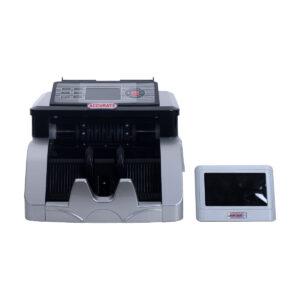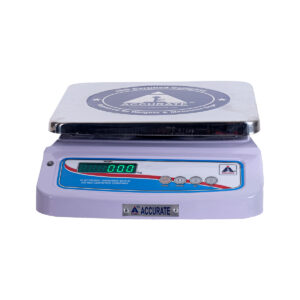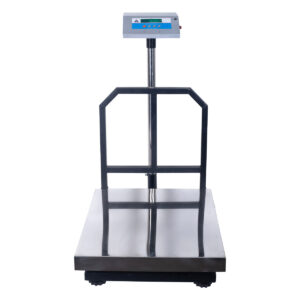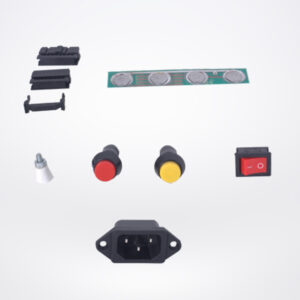collaborating weighing scale
Calibrating weighing scales/instruments
1. Preparations before calibration:
Before you can start the calibration of the weighing instrument, you should clarify a few things and get prepared. You should find out the technical characteristics of the weighing instrument (max weight, d value), the accuracy requirement (max error allowed and uncertainty) and what to do if the calibration fails (adjustment). Typically, the whole measurement range is calibrated and the calibration is performed in the location where the instrument is being used. Make sure you have enough weights for the calibration procedure available. The weighing instrument should be switched on atleast 30 minutes before the calibration. The temperature of the weights should be stabilized to the same temperature where the calibration is to be done. The weighing instrument should be at a horizontal level, especially for small and accurate weighing instruments. Perform a few pre-tests by placing weights close to the maximum of the range on the instrument and to ensure it works normally. In case the weighing instrument fails in calibration and it is adjusted, you should make an “as found” calibration before adjustment and an “as left” calibration after adjustment.
2. Eccentricity Test:
In normal use of a weighing instrument, the load is not always placed perfectly on the center of the load receptor. Sometimes the results of a weighing instrument can vary slightly depending on if the load is placed in different locations on the load receptor. In order to test how much effect the location of the load has, the eccentricity test is performed. In the eccentricity d bd test, the reference load is placed in a few different specified locations on the load receptor. First, the load is placed in the center of the load receptor (the load’s center of gravity) and the result is observed. Next, the load is placed in four different sectors of the load receptor, as illustrated in the picture which is for rectangular and round load receptors, but naturally, in practice, there are many different shapes of load receptors and the location of the load will vary. Standards OIML R76 and EN 45501 will give guidance for different load receptor shapes. The calibration procedure should specify where to place the load during the test and calibration results (in certificate format) should also document the locations. The test load used in an eccentricity test should be atleast one-third (1/3) of the max load of the weighing instrument. The test should preferably be done using just one test load, if possible. That way it is easier to be sure that the load’s center of gravity is in the specified location. For a weighing instrument with multiple ranges, the eccentricity test should be done with the highest range. As the aim of the eccentricity test is to find out the difference caused by the location of the load, it is not necessary to have an accurate calibrated load. It is naturally important to use the same load throughout the test. If the eccentricity test is used also to determine the errors of the indication, then a calibrated load should be used.
3. Procedure for the Eccentricity Test:
The indication is zeroed before the test. The test load is placed to location 1 and indication is recorded. The test load is then moved to locations 2 to 5 and indication is recorded in each location. Finally, the test load is placed again to location 1 to check that the indication has not drifted from the earlier indication in location
1. The zero may be checked between each location to see that it has not changed. If necessary, the instrument can be zeroed in between each test.
Alternatively, you may also tare the instrument when the load is in location number 1, as this makes it easier to see any difference between locations
1. Preparations before calibration:
Before you can start the calibration of the weighing instrument, you should clarify a few things and get prepared. You should find out the technical characteristics of the weighing instrument (max weight, d value), the accuracy requirement (max error allowed and uncertainty) and what to do if the calibration fails (adjustment). Typically, the whole measurement range is calibrated and the calibration is performed in the location where the instrument is being used. Make sure you have enough weights for the calibration procedure available. The weighing instrument should be switched on atleast 30 minutes before the calibration. The temperature of the weights should be stabilized to the same temperature where the calibration is to be done. The weighing instrument should be at a horizontal level, especially for small and accurate weighing instruments. Perform a few pre-tests by placing weights close to the maximum of the range on the instrument and to ensure it works normally. In case the weighing instrument fails in calibration and it is adjusted, you should make an “as found” calibration before adjustment and an “as left” calibration after adjustment.
2. Eccentricity Test:
In normal use of a weighing instrument, the load is not always placed perfectly on the center of the load receptor. Sometimes the results of a weighing instrument can vary slightly depending on if the load is placed in different locations on the load receptor. In order to test how much effect the location of the load has, the eccentricity test is performed. In the eccentricity d bd test, the reference load is placed in a few different specified locations on the load receptor. First, the load is placed in the center of the load receptor (the load’s center of gravity) and the result is observed. Next, the load is placed in four different sectors of the load receptor, as illustrated in the picture which is for rectangular and round load receptors, but naturally, in practice, there are many different shapes of load receptors and the location of the load will vary. Standards OIML R76 and EN 45501 will give guidance for different load receptor shapes. The calibration procedure should specify where to place the load during the test and calibration results (in certificate format) should also document the locations. The test load used in an eccentricity test should be atleast one-third (1/3) of the max load of the weighing instrument. The test should preferably be done using just one test load, if possible. That way it is easier to be sure that the load’s center of gravity is in the specified location. For a weighing instrument with multiple ranges, the eccentricity test should be done with the highest range. As the aim of the eccentricity test is to find out the difference caused by the location of the load, it is not necessary to have an accurate calibrated load. It is naturally important to use the same load throughout the test. If the eccentricity test is used also to determine the errors of the indication, then a calibrated load should be used.
3. Procedure for the Eccentricity Test:
The indication is zeroed before the test. The test load is placed to location 1 and indication is recorded. The test load is then moved to locations 2 to 5 and indication is recorded in each location. Finally, the test load is placed again to location 1 to check that the indication has not drifted from the earlier indication in location
1. The zero may be checked between each location to see that it has not changed. If necessary, the instrument can be zeroed in between each test.
Alternatively, you may also tare the instrument when the load is in location number 1, as this makes it easier to see any difference between locations
















